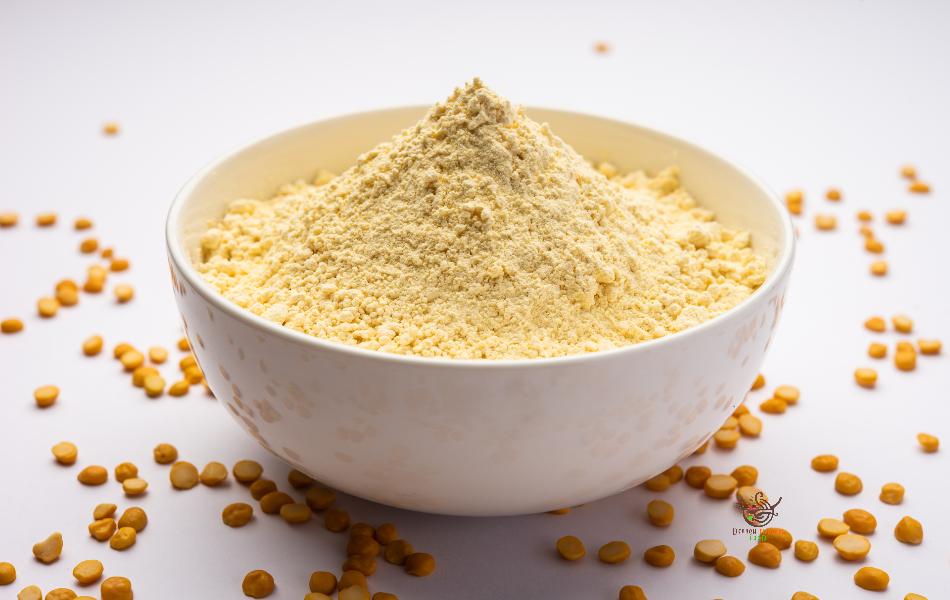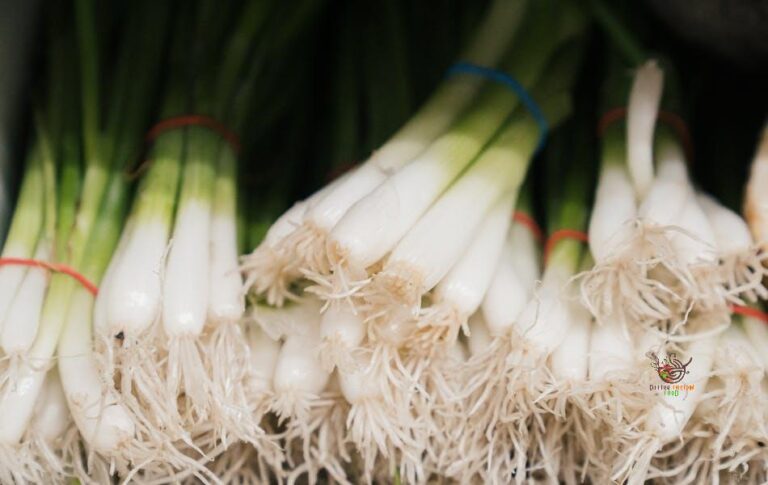Substitutes for Gram Flour: Try These 16 Alternatives
Flour has become a common ingredient in various cuisines, contributing to the texture and flavor of many crunchy and nutty dishes. Gram flour is widely used in Middle Eastern, Indian, Asian, and French cuisines, especially in various spicy dishes.
Don’t worry if you don’t have gram flour, as several other options can replace it. These substitutes may not deliver the exact nutty flavor. But they do offer a comparable texture. Dive into the following paragraphs to discover some of the best substitutes for gram flour that you can easily incorporate into your cooking.
What is Gram Flour?
Gram flour is a gluten-free flour made by grinding dried chickpeas. It’s a common ingredient, though some people may be less familiar with it.
Gram flour’s earthy flavor and powdery texture work well in spicy dishes. Coating deep-fried jalapenos and vegetables in gram flour creates a crispy, nutty snack.
To understand gram flour, let’s talk about the two types of chickpeas used to make it. You can make gram flour from Kabuli or Desi chickpeas.
Kabuli chickpeas, beige in color, produce lighter flour, whereas Desi chickpeas are smaller and darker. In general, gram flour possesses a pronounced nutty flavor, as mentioned earlier. Due to the darker color of Desi chickpeas, dishes baked or fried with this variety may attain a richer golden hue.
When mixed with liquid, gram flour becomes a thick, sticky batter. It is used to bind veggie burgers, thicken soups and stews, and as an ingredient in pancakes, muffins, and pastries.
Nutritional Content
Gram flour is a nutrient-rich substance, packed with fiber, carbohydrates, vitamins, and minerals. A one-cup serving of gram flour typically contains:
- 356 calories
- 20 grams of protein
- 53 grams of carbohydrates
- 10 grams of fiber
- 2 grams of fat
Moreover, gram flour is a noteworthy source of essential minerals such as iron and magnesium, contributing to overall health.
Health Advantages
Beyond its culinary utility, gram flour brings health benefits to the table. Its high fiber content aids in blood sugar regulation and promotes digestion. The substantial protein content in gram flour is crucial for tissue building and repair. Furthermore, gram flour packs several vitamins and minerals vital for overall well-being.
While gram flour is a nutritious choice, its high carbohydrate content warrants moderation in consumption, emphasizing its place in a well-balanced diet.
Substitutes for Gram Flour
While the alternatives mentioned here may not replicate the exact nutty and savory taste of gram flour, they do provide a similar texture and flavor to a considerable degree.
1. All-Purpose Flour
All-purpose flour is a quick and accessible substitute for gram flour. However, it’s less absorbent, so use 1 ¼ cups for every 1 cup of gram flour. Note that it contains gluten, making it unsuitable for those with celiac disease. Additionally, all-purpose flour is lower in protein and fiber, and higher in carbs compared to gram flour, resulting in a lighter texture.
2. Millet Flour
Millet flour serves as a fantastic source of nutrition. It also enhances the texture of various baked goods, including those inspired by Indian recipes.
It’s an excellent substitute for gram flour. If you’re looking for a gluten-free option, millet flour is a fantastic choice.
You can use millet flour instead of gram flour in an equal ratio. However, it has a bitter aftertaste that’s. Hence, combining millet with another flour, like soybean or rice flour, is recommended.
3. Corn Flour
Corn flour serves as an excellent substitute for gram flour, providing effective binding and thickening properties. It can be used in various recipes, although it might be denser for dishes like Pakoras or Cheela. The subtle flavor of corn adds richness to your meals when used as a substitute.
4. Wheat Flour

Wheat flour, a frequent substitute in baking, is made from ground wheat. It includes gluten, serving as an effective thickening agent. For a healthier choice, opt for whole wheat flour over refined wheat flour, as it offers more fiber and nutrients.
5. Tapioca Flour
Tapioca flour, derived from cassava roots, is a chewier alternative to gram flour. It excels as a coating for fried foods and serves as an excellent thickening agent. However, it’s not recommended to bake with tapioca flour alone due to its pure starch content. It’s best used in combination with another flour.
6. Whole Wheat Flour
Whole wheat flour is a suitable non-gluten-free substitute. Unlike gram flour, it has a more neutral flavor and a grainy texture. Being more fibrous, it works well as a chickpea substitution, particularly in bread, muffins, or cookies. You can replace gram flour with whole wheat flour at a 1:1 ratio. If whole wheat flour is unavailable, all-purpose flour can be used as an alternative, though it won’t offer the same taste.
7. Spelt Flour
Spelt flour, made from the spelt grain, features a delicate yet nutty scent that won’t overpower your baked goods. It is a healthy alternative to gram flour in recipes like cookies, granola bars, or brownies. Not suitable for recipes requiring flour to rise, such as bread and cake, but if used in these recipes, combining it with something like wheat flour can yield a fluffier end product.
8. Soybean Flour
Consideration should be given to the potential effects on thyroid function before using soybean flour as a substitute for gram flour. Individuals with hyper- or hypothyroidism should avoid soybean flour. Despite this, soybean flour is a rich source of protein and serves well as a gram flour alternative. It boasts a mild yet similarly nutty taste, and its versatility is nearly comparable.
9. Lentil Flour
Lentil flour, a gluten-free alternative made from ground lentils, is a suitable substitute for gram flour. Rich in protein and fiber, it can be used in various recipes. It offers a slightly nutty flavor adaptable to both sweet and savory dishes.
10. Buckwheat Flour
Buckwheat flour, being gluten-free, serves as an excellent alternative when gram flour is unavailable. It boasts a rich and savory flavor, ideal for coatings and thickening. While it may not be suitable for most desserts, its low glycemic index, high protein, and calcium content make it a healthy option for baking enthusiasts.
11. Quinoa Flour
Quinoa flour is yellowish-white in color and made by crushing dried quinoa seeds. It has a fine texture, ideal for nuggets and quinoa balls. Baked goods with quinoa flour are fluffy, moist, and somewhat chewy. Additionally, it serves as an excellent binder, allowing you to use a tablespoon or two to make burgers or kebabs.
12. Rice Flour
Rice flour is gluten-free, offering a fantastic and healthy alternative to gram flour. It thickens similar to gram flour and serves well as a coating. Notably, rice flour absorbs less oil, resulting in lower calories and an improved overall texture. It reduces the likelihood of meat or vegetables turning out oily, preserving their original flavors.
13. Oat Flour
Oat flour is a versatile alternative to gram flour, being both gluten-free and readily available. You can easily make oat flour by processing oats or oatmeal, similar to homemade gram flour. With a mild and sweet flavor, oat flour complements dense-textured desserts like chocolate brownies or vanilla muffins. For spongy and airy cakes, use this gluten-free flour in combination with another flour. Beyond baking, oat flour is excellent for thickening soups and stews.
14. Almond Flour
Almond flour is a well-known low-carb ketogenic option. It is used to limit carbohydrate consumption or, in our case, as a substitute for gram flour.
Almond flour is typically made from skinned almonds. However, some versions, known as almond meal, include the skins and can be used as an alternative to gram flour. This variety is widely accessible, offering a mild nutty, sweet flavor with a relatively neutral scent. It’s also quite healthy and works best in sweet recipes.
15. Coconut Flour
Coconut flour is crafted from ground coconut meat and is a low-carb, keto-friendly, and gluten-free alternative. With a high fiber content and a slightly sweet taste, it is an excellent substitute for gram flour in sweet recipes, including cakes, cookies, and muffins.
16. Cassava Flour
Cassava flour is a gluten-free option derived from the ground cassava root, rich in carbohydrates and a good source of fiber. With a neutral taste, it can be used in various recipes. The flavor of cassava flour is somewhat reminiscent of chickpea, emitting a nutty aroma in the dough, though not overpowering. A classic Caribbean dish, Cassava pone, highlights this aroma prominently. Apart from Cassava pone, the flour is versatile for making muffins, brownies, bread, and other baked goods.
How to Make Homemade Gram Flour
If you can’t find gram flour in your local grocery store, making it at home using dried chickpeas is both easy and cost-effective.
Blender or Food Processor
- Wash and drain dried chickpeas to eliminate debris.
- Lay out chickpeas on a baking sheet, allowing them to dry thoroughly.
- After drying, use a blender or food processor to grind chickpeas into a fine powder.
- Sift the powder to eliminate large pieces.
- Store the resulting gram flour in an airtight container.
See Also – 4 Best Manitoba flour Substitutes
Conclusion
Numerous worthy substitutes for gram flour exist, each imparting its unique flavor. Options range from nutty oatmeal powder to neutral rice flour, depending on the recipe. Achieve outstanding crispiness and excellent plain-taste thickening. Many chefs find the best results by combining different flours, so experiment and discover tasty combinations!







